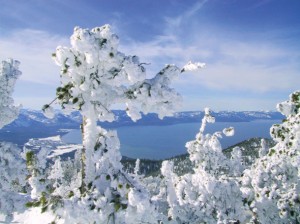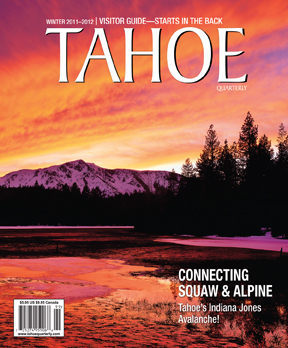Of Ice and Snow in Tahoe
Nature uses winter water for warmth, protection
Written by Will Richardson
The Planet Earth we know could not survive without its most important and unique substance, water. It surrounds us, covering approximately 70 percent of Earth’s surface, locked away for long periods as snow and ice, as vapor in the atmosphere, in the soil, or deep underground beneath our feet. As the chemical basis for life, it composes a large percentage of all living things. In a typical vista at Tahoe, we see water occurring naturally in all three physical states: gas, as clouds in the blue sky; solid, as snow on the mountainsides; and liquid, as The Lake itself. Things get interesting when you look at how these states transition and the way these properties determine how organisms survive the long winter season.
Perhaps the most vital property of water is that, unlike almost all other substances, its molecules crystalize into a solid less dense than its liquid form, which causes ice to float. Cold water does sink, and this plus stormy weather helps mix nutrients and oxygen in any body of water. When water temperature drops below approximately 39 degrees Fahrenheit, however, it begins rising back to the surface. If ice sank when it formed, life on Earth would look very different. Ice would accumulate beneath bodies of water, and many might freeze solid. Among many other unfathomable implications, the scenario would create an unstable climate and dire consequences for any organisms trying to live in water. Life itself might not exist.
Thankfully, ice forms at the top, providing an insulating layer for the water below to remain liquid, and for ponds, rivers and lakes to sustain rich ecological communities through winter. Beavers and muskrats have to slow down considerably, due to the ice hindering their movements and large storms forcing them to sleep. Aquatic plants receive little sunlight, and in dying and decomposing even less oxygen is available for the other organisms. For many cold-water fish and invertebrates, however, life under the ice means business as usual, minus the threat of aerial assault from kingfishers, eagles and osprey. Similar insulating effects found underneath the snowpack give myriad species protection from colder air temperatures above. Species like voles, which have little problem finding food under the snow, also receive protection from many summer predators, freeing them to reproduce through the winter with relative impunity. For anyone with a lawn in the Tahoe region, springtime provides plentiful evidence of these freedoms.
The expansion of water as it freezes, combined with the jagged crystalline form it takes, wreaks havoc on the cell walls and organelles (the important inner workings of cells) of soft tissue. Imagine a blob of microscopic razor blades expanding in every direction at once. This tissue damage, known as frostbite, has served as a considerable evolutionary force for most organisms living in the Sierra Nevada. For example, aspen and cottonwood trees have thin leaves vulnerable to such freezing, one of the reasons they must drop those leaves in the fall. Like most perennial plants, they go dormant during conditions unfavorable for growth or reproduction (although aspens do have enough chlorophyll in their bark to take advantage of warm, sunny stretches during the winter). Conifer trees, by contrast, retain their needlelike leaves for years at a time. While pines and firs may go dormant during particularly stressful conditions, they kickstart photosynthesis whenever those conditions relent. The small surface area and thick waxy coating of conifer leaves help reduce vapor loss, and altering the chemistry within and between individual cells promotes the formation of ice crystals between the cells, instead of within the cells. Amazingly, many animals pull off this sort of trick as well, including our familiar Sierra chorus frog. The formation of the first ice crystals in the frog’s skin sets off a chain reaction where the frog’s liver pumps out a massive amount of glucose to serve as antifreeze within the cells. Outside the cell walls, special proteins act as nucleation sites to promote the formation of ice crystals away from where they can do harm. This further pulls most of the water out of the frog’s cells, and effectively the frog freezes completely solid while all life functions are put on hold, brain quiet, no heartbeat. The frogs can survive in this suspended state for weeks at a time. In late winter, when the time is right, they slowly thaw out over a period of many hours. Their hearts resume beating, and the frogs immediately gear up for what comes next—mating season!
Will Richardson is the co-executive director at the Tahoe Institute for Natural Science.
Category: Natural World, Outdoors, Winter







